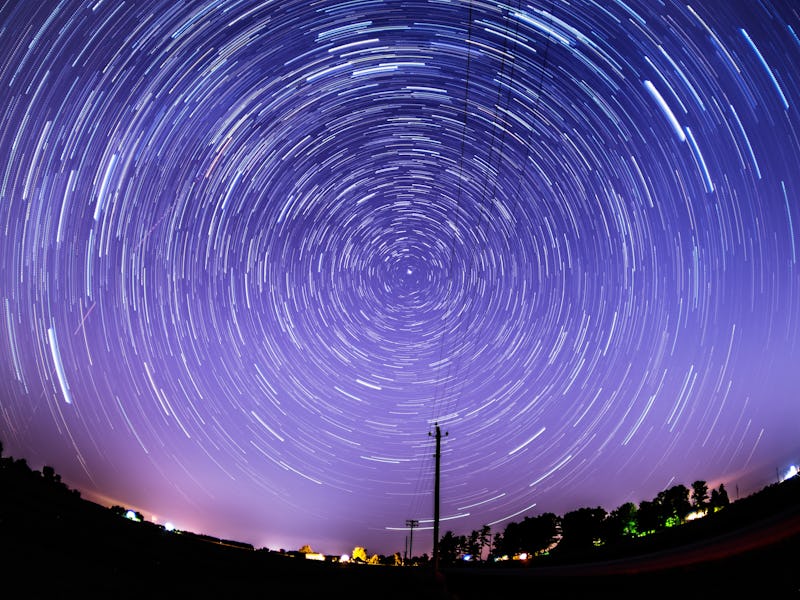You need to see the most unpredictable meteor shower peak this week
The Draconids may not be as prolific as some meteors but they are fascinating none-the-less.

The Draconids are the dark horse of the annual meteor showers. Typically, they don’t put on the same glitzy display as the Perseids, but there’s always a small chance that this year might be different. Every so often, the Draconids show up and show out with a “storm” during which you might see many meteors every hour. And this year’s opportunity for something truly rare is upon us: Look to the skies during the overnight peak on Saturday, October 8, and Sunday, October 9.
The Moon will try to take the Draconids’ limelight this year, as it is still in its waxing gibbous phase. But the meteor shower is always interesting due to its comet origin story, as NASA explains.
WHAT CAUSES METEOR SHOWERS?
The Draconids, like all meteor showers, are generated when streams of interplanetary dust essentially collide with Earth during our planet’s orbit around the Sun. The dust in question is typically the waste debris left behind from comets (icy snowballs) or asteroids (space rocks). When Earth and dust cloud meet, the results are generally harmless, often spectacular meteor showers, which blaze trails of light as the meteors enter and burn in our atmosphere.
When we see shooting stars or meteor showers, we are seeing the Solar System’s volatile history in action. Comets and asteroids have been around in the Solar System for longer than planets. The force of the Sun’s gravity over the eons causes these little worlds to fall apart and leave a trail of dust in their wake. That dust becomes our natural light show from the heavens.
Comet 21P/Giacobini-Zinner, the origin of the Draconids.
HOW OLD IS THE DRACONID METEOR SHOWER?
According to EarthSky, the Draconids (previously called the Giacobinids) were not reported until the 21st century.
The comet that generates the meteors was found on December 20, 1900, by French astronomer Michel Giacobini. Then, in October 1913, German astronomer Ernst Zinner reconfirmed the comet’s existence. As a result, the comet now bears two names: 21P/Giacobini-Zinner. It has a 6.6-year orbit around the Sun and will make its next close approach in March 2025.
The comet was found at a time in science history when astronomers were learning how meteors and comets were related. And helping to drive the interest were at least two spectacular Draconid shows in the mid-20th century, when the dust stream was positioned advantageously to Earth’s orbit.
“During its peak in 1933, 500 Draconid meteors were seen per minute in Europe. 1946 was also a good year for the Draconids, where 50-100 were seen per minute in the U.S.,” NASA reports.
WHERE TO SEE THE DRACONID METEOR SHOWER
The meteors appear to come from the head of Draco (the Dragon), which is best visible in the northern hemisphere. “Draco” refers here to the International Astronomical Union designation of this sky region, by the way; you may have a different designation in your own country or culture.
While Draco is hard to find, you can get pretty close if you look for the Little Dipper or Ursa Minor in the sky. It’s not too important to find the constellation exactly, especially because the brighter meteors tend to be seen further from the radiant. Your greatest obstacle will be the bright Moon, but it should set after midnight and allow a few hours of clear viewing.
To see what meteors you can, go out around 2 a.m. local time and give your eyes at least 20 minutes to adjust to the darkness. You don’t need to bring any telescopes or binoculars, although you might want a lawn chair and something to wear to stay warm.
The key is to relax and to preserve your night vision for the best chance of seeing meteors. If you must use a sky chart, use red filters or tape to cover your flashlight or phone.
The streak of a meteor
DRACONID METEOR SHOWER 2022 PREDICTION
This year isn’t supposed to be a great year for Draconids, mostly because its parent comet isn’t near Earth in its orbit at the moment. EarthSky reports the show generally produces about five meteors an hour during these conditions. So the key will be patience.
Happily, other meteor showers are a little more rich than the Draconids typically are, so consider this practice.
WHEN IS THE NEXT METEOR SHOWER FOR 2022?
The next meteor shower will be the Orionids, which peak on Friday, October 21 and generally produce a good show. Another one to watch for is the Leonids, which peaks on Thursday, November 17 and which usually produces bright meteors for your viewing pleasure.